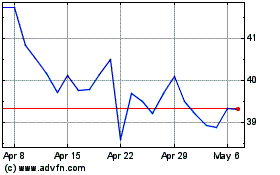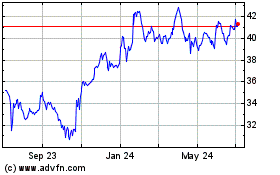Verizon Adds Wireless Customers, Takes Another Hit on Yahoo Unit -- Update
January 30 2020 - 8:46AM
Dow Jones News
By Sarah Krouse
Verizon Communications Inc. added lucrative phone customers at a
healthy clip in the final three months of 2019 as it worked to
build out a faster 5G network, but it continued to grapple with its
digital-media business.
The largest U.S. mobile carrier by subscribers added 790,000
postpaid phone connections during the period, compared with 653,000
during the same period a year earlier. JPMorgan Chase analysts
expected the carrier to add about 750,000 such connections.
Postpaid customers are considered lucrative for carriers because
those subscribers typically pay up monthly under longer-term
contracts and are less likely to switch providers. Verizon's
largest rival, AT&T Inc., added 229,000 postpaid phone
connections during the period, while T-Mobile US Inc. added one
million such connections.
Verizon took a roughly $200 million charge to write-down the
value of its media business, which is home to Yahoo and AOL web
properties. Revenue within Verizon Media Group was flat
year-over-year at about $2.1 billion as it continued to confront
declining desktop search revenue.
In late 2018 Verizon took a $4.5 billion accounting charge
related to that business and has since tried to focus on e-commerce
and Yahoo-branded news, sports and entertainment services.
Shares of Verizon slipped 2% in premarket trading. The stock has
advanced about 10% over the past year, lagging behind a broader
market rally.
Verizon has focused on partnerships, rather than major
acquisitions, to attract and retain customers in recent years. The
carrier offers wireless and home-internet customers varying degrees
of free access to streaming services including YouTube TV, Disney+,
Apple Music and Google Stadia videogaming.
The company reported 119.8 million wireless connections,
including tablets, smartwatches and other devices, up from 118.65
million at the end of September.
The mobile carrier, like its rivals, is in the process of
building out 5G service in dozens of cities and is in search of new
business and consumer uses of the next-generation service.
Executives have said 5G's fast speeds and low latency will
transform manufacturing, entertainment and transit.
For now, however, 5G's reach is limited. Verizon is using ultra
high-frequency airwaves for its 5G service, relying in the early
days on spectrum that can't travel long distances or penetrate
walls. That has led to more limited coverage than rivals using mid-
and low-band spectrum.
As it builds out its 5G network, Verizon is trying to generate
more revenue by convincing wireless customers to migrate to
unlimited data plans. It has encouraged families to mix and match
the plans they use, which helps the carrier nudge consumers to
pricier plans when they want higher-quality TV streaming or more
hot-spot usage.
While the carrier added cellphone customers, its pay-television
service, Fios video, lost 51,000 connections in the quarter, and
added 35,000 Fios internet connections.
Verizon earlier this month said it would do away with
traditional cable bundles and allow customers to also mix the home
internet and cable television plans they want without long-term
contracts. That move was the start of a long process of
de-emphasizing video, an area in which Verizon lacks scale in
negotiating programming costs, Citigroup analysts said at the
time.
Overall, net income attributable to Verizon was $5.1 billion in
the fourth quarter, compared with $1.9 billion a year earlier. The
year-ago quarter was weighed down by the large write down on the
media business. Revenue rose to $34.8 billion from $34.3 billion a
year ago.
The company said it has cut $5.7 billion of the $10 billion in
expenses it has vowed to eliminate by 2021. It ended 2019 with
135,000 employees, down from 144,500 at the end of 2018 following a
voluntary buyout program.
Write to Sarah Krouse at sarah.krouse@wsj.com
(END) Dow Jones Newswires
January 30, 2020 08:31 ET (13:31 GMT)
Copyright (c) 2020 Dow Jones & Company, Inc.
Verizon Communications (NYSE:VZ)
Historical Stock Chart
From Apr 2024 to May 2024

Verizon Communications (NYSE:VZ)
Historical Stock Chart
From May 2023 to May 2024
